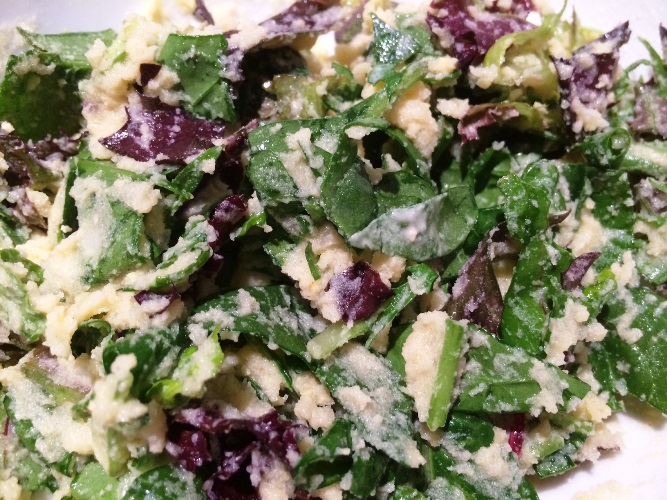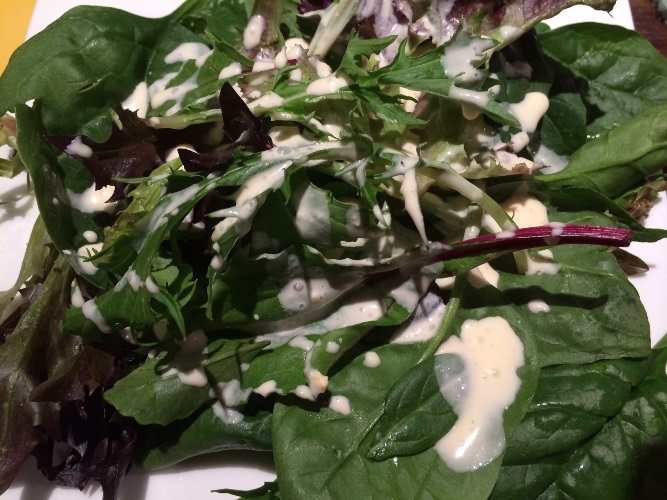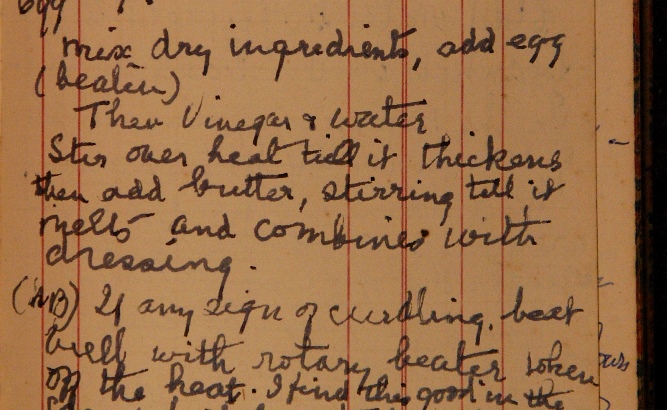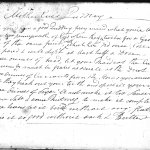It’s not often you find a poet in the kitchen, but recording recipes as poems was not an uncommon practice in the nineteenth century. ‘Mother Eve’s pudding‘ is included in Edward Abbott’s English and Australian Cookery Book (for the many and the upper ten thousand), Thackeray wrote an ‘Ode to curry’, but I digress… More pertinent to our summer salads theme, I recalled Sydney Smith’s salad recipe ‘in verse’ (also in Abbott) penned in 1839.
The poet’s receipt for salad
Two large potatoes, passed through kitchen sieve
Unwonted softness to the salad give
Of mordent mustard, add a single spoon,
Distrust the condiment which bites so soon
But deem it not, thou man of herbs, a fault,
To add a double quantity of salt:
Three times the spoon with oil of Lucca crown,
And once with vinegar, procured from town;
True flavour needs it, and your poet begs
The pounded yellow of two-well-boiled eggs;
Let onion atoms lurk within the bowl,
And, scarce suspected, animate the whole;
And lastly, in the flavoured compound too
A magic teaspoon of anchovy sauce:
Then, though green turtle fail, though venison’s tough,
And ham and turkey are not boiled enough,
Serenely full, the epicure may say –
Fate cannot harm me, – I have dined to-day.Sydney Smith, 1839, (first published, according to Eliza Acton, in her Modern cookery for private families, 1845)
Following the poem Eliza instructs to ‘stir up the salad immediately before dinner, and stir it up thoroughly’ but as you may gather from reading it through, and became evident when I trialed it, this is less of a salad and more of a dressing, and quite a heavy one at that. Eliza notes (in the small print at the bottom of the page) ‘the mixture forms almost a substitute for salad, instead of a mere dressing’. It could almost be regarded a mashed potato salad, but once made, is a surprisingly tasty addition to a cos lettuce sliced up, or with slices of celery mixed through it. If it’s too thick you can loosen it up with a little more oil or vinegar, according to taste. Rather than press the cooked potatoes through a sieve, use a fine grater, and instead of anchovy sauce, which is not readily available in Australia, use a teaspoon or two of oil from a jar of anchovies.
Saucy stuff
So it seems that salads, and recipes for them, were more often about the dressing than the salad. And an 18th-century or 19th-century salad would quite often consist of one single salad veg rather than a combination – lettuce, celery or cucumbers, sliced finely and mixed through a sauce or dressing. The dressing may be as simple as a splash of vinegar from a jar of pickles, or quite rich and complex, as Sydney Smith’s poem indicates.
Recipes for English salad dressings (and early Australian ones, by default) are typically creamy, in colour and consistency. They’re sometimes referred to as a salad sauce rather than a dressing.
Getting down to basics
Egg yolks are the essential foundation for an English dressing, but unlike French style mayonnaise, yolks from hard boiled eggs are used rather than raw eggs, which is quite clever actually, having less risk of curdling. Eliza Acton advises,
‘the first essential for a smooth, well-made English salad dressing is to have the yolks of the eggs sufficiently hard to be reduced easily to a perfect paste. they should be boiled … well covered with water [for] at least fifteen minutes, and should have become quite cold before they are taken from the shells…’
Typically, two yolks are mashed with the back of a wooden spoon (metal spoons can leave hard lumpy bits) or worked through a fine sieve, then seasoned with a little salt, sugar and cayenne mixed through with a teaspoon of cold water. Half a cup of fresh cream (thickened or double cream probably gives best consistency) is added little by little until the egg mixture is fully incorporated and smooth, then, stirring constantly, enough vinegar worked in to ‘acidulate the mixture agreeably’.
Eliza Acton’s English sauce for salad
Ingredients
- 2 egg yolks, from cooled hard-boiled eggs
- 1/2 teaspoon sugar
- pinch cayenne pepper (or substitute with white pepper)
- 1/2 cup thickened or double cream
- 2 tablespoons tarragon vinegar or white wine vinegar, or more to taste
- splash Tabasco sauce, optional
Note
This recipe is from Eliza Acton’s Modern cookery for private families, first published in 1845. Additional flavours can be added, such as worcestershire, mushroom or anchovy sauce (or anchovies mashed until smooth), a pinch of mace or nutmeg, or a hint of garlic rubbed into the bowl from a freshly cut clove before mashing the yolks.
Directions
| Mash the yolks in a mixing bowl using the back of a spoon until very smooth. Add sugar, cayenne or white pepper, and a good pinch of salt, and work into the egg paste with a teaspoon of water. | |
| Add cream a little at a time, stirring into the paste to keep a smooth consistency. | |
| Stirring or whisking briskly, add vinegar a little at a time until incorporated into the cream. Add Tabasco sauce, if using. Taste and add more vinegar if desired. Adjust seasoning. | |
| Dressing will store in fridge for a few days, with the surface covered with plastic wrap. Whisk again just before using. | |
The good oil
The notion that Australians did not commonly use olive oil, and that it could only be procured from chemists shops until post-war immigrants from Europe settled here in the 1950s and 60s . As we know, it was an experimented with in the very early colony by the Macarthur family and others of their ilk, and imported olive oils were commonly found in grocer’s shops, and listed in domestic accounts from the 19th century as its place of origin – Lucca, from Central Italy, as mentioned in Sydney Smith’s poem, for example, or simply, salad oil.
Eliza Acton offers an olive oil version of her recipe above, resulting in a different flavour profile and texture. She says,
‘six tablespoonsful of olive oil, of the purest quality, may be substituted for the cream (but omit the water): it should be added in very small portions to the other ingredients, and stirred briskly as each is added until the sauce resembles custard.’
The flavour can be varied according to the vinegar chosen, or a dash of prepared mustard, mashed anchovies or Worcestershire sauce (Eliza recommends ‘Harvey’s sauce’, which seems to have been lost to history).
Salad cream
There’s a current trend in restaurants, along with the resurgence of interest in the iceberg lettuce perhaps, for old-style salad creams. A style rather than a particular recipe, the term probably originates from the use of cream in dressings as per the example given above. The salad creams I grew up, served over wedges of iceberg lettuce or in coleslaws, had a particular sweet-sour piquancy, which I’d forgotten how much I appreciated. Childhood memories came flooding back of my mother, who was a typical 1970s short-cuts cook and used the cheats recipe, whisking ‘skipping girl’ vinegar into condensed milk from a small tin.
Purists, or those looking for more traditional techniques might prefer to follow Mrs Wiseheart’s recipe found in the family manuscript recipes collection at Meroogal in coastal New South Wales (modern redaction below). It is quite typical of a ‘cooked’ salad dressing popular in the early 1900s, and being enriched with butter, it has all the makings of a bearnaise sauce but is not quite as temperamental. It’s not dissimlar to the Australian salad dressing Mrs Maclurcan’s cookery book, but makes a more modest batch.
Mrs Wiseheart’s salad dressing
Ingredients
- 1/4 cup white vinegar or white wine vinegar
- 1 egg
- 2 Scant tablespoons sugar
- 2 teaspoons plain flour
- 1 heaped teaspoon mustard powder (or ready made Dijon)
- 1/2 teaspoon ground white pepper (optional)
- pinch salt, or to taste
- 30g butter, cut into three pieces
Note
This dressing is in the ‘salad cream’ style. It is delicious drizzled over cos lettuce, steamed asparagus or hot-smoked trout.
NOTE: As the dressing contains egg, it must be stored in the refrigerator quite quickly after making and used within a few days. It may appear a bit of a fuss to make, but is actually quite simple, and more forgiving than a mayonnaise. It's a nice change from oil and vinegar dressings and you can adjust the sugar/mustard/salt ratio to taste. Add fresh herbs from the garden when serving or use a herb vinegar – tarragon vinegar would work well.
Directions
| Mix the vinegar with 3/4 cup of water in a jug or bowl. Whisk the egg in a separate bowl until frothy then whisk it into the vinegar mixture a little at a time. | |
| Half-fill a saucepan with water and bring to a simmer over medium heat. Meanwhile, sit a mixing bowl that is wider than the saucepan over the pan, or use a double boiler. Put the sugar, flour, mustard powder, salt and pepper (if using) into the bowl. Strain the vinegar and egg mixture into the dry ingredients and mix well with a balloon whisk. Place the bowl over the saucepan, ensuring it is stable, and whisk the mixture for about 8–10 minutes, until it starts to thicken slightly. Add the butter, one piece at a time, and whisk until it melts and is fully incorporated into the dressing. Stir for another 2 minutes with a wooden spoon – the mixture should have a silky gloss and thinly coat the back of the spoon. (If you taste the dressing at this stage it may seem sharp, but it will mellow and balance as it chills. Adjust the seasoning once it has chilled.) | |
| COOK'S TIP – whisking the ingredients in a double boiler should minimise the risk of the egg curdling, however, a note on the original recipe says, 'If any sign of curdling, beat well with rotary beater [or a whisk] when off the heat. Add small lump of butter, & beat till smooth'. | |
| Remove the bowl from the heat and pour the dressing into a small jug or bowl to cool slightly (about 10 minutes) before covering the surface with plastic wrap or silicone paper to prevent a skin forming. Store the dressing in the refrigerator, where it will thicken to the consistency of pouring cream. Keep refrigerated until required. | |
| COOK'S TIP – whisking the ingredients in a double boiler should minimise the risk of the egg curdling. However, a note to the original recipe says: ‘If any sign of curdling, beat well with rotary beater (whisk) when off the heat. Add small lump of butter, & beat till smooth’. | |


 Print recipe
Print recipe




